Manilla
Authr: Franz-Benno Delonge
Publisher: 999 Games (orig. Zoch Verlag)
Year: 2006 (2005)
review by

| x |
|
|
|
|
|
|
|
|
|
|
|
|
|
|
|
|
|
|
|
|
|
|
|
|
|
|
|
|
|
|
|
|
|
|
|
|
|
|
|
|
|
|
|
|
|
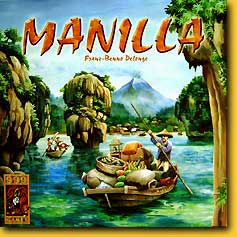 |
All ships itineraries in this game lead to Manilla, but unfortunately the captain has no say in how fast the boats sail, as they all are equipped with unreliable engines. The engines are represented by dice in the colours of the participating ship loads, of which only three of four fit in the groove; the port warden of the current round decides which colour is left out. Preceding the three dice rounds that the way lasts, three to five players try with their accomplices to participate in one or more boats of which they think or hope will reach the harbour, or take other interests along the shore.
The goods that will be shipped and their revenues are known in advance as they have been chosen by the warden. When a ship enters the harbour, the revenues are divided evenly among the participating accomplices on the boat, and the type of goods rises one position on the stock market. Stock can be bought, and the value of the stock is paid off at the end of the game, with the player winning who has accumulated the most money.
|
| x |
|
|
|
|
|
|
|
|
|
|
|
|
|
|
|
|
|
|
|
|
|
|
|
|
|
|
|
|
|
|
|
|
|
|
|
|
|
|
|
|
|
|
|
|
|
| So, why not give me three stock of nutmeg and two of ginseng then? Unfortunately, things do not come this easy: only the warden may buy one, and just one, stock of any kind. Who does not want to be the harbour warden then? Just so, so just start your bidding because this advantageous position is for sale and goes to the highest bidder. When manning the post he picks three goods and puts each on a boat, the fourth good stays behind and has no chance of rising in value this round. |
|
|
| x |
|
|
|
|
|
|
|
|
|
|
|
|
|
|
|
|
|
|
|
|
|
|
|
|
|
|
|
|
|
|
|
|
|
|
|
|
|
|
|
|
|
|
|
|
|
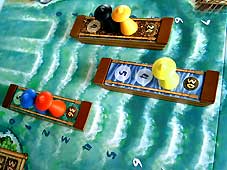 |
|
But even from the participating three ships it remains unclear if they will reach the harbour; in three dice rounds the ships must have passed the finish: in three die rolls a total of 13 must have been rolled. Or some less, because before the ships start off, the warden has another advantage he may perform: he may divide nine points between three ships by advancing them already some spaces, one point for every space, with a maximum for five points on any one ship. So one ship stays at position 0, while another already starts off at position 5, and the third at position 4. This way it may become more probable which ships will cross the finish line, and are among the favorites for boarding an accomplice. One by one players can let them board, but only one per round, after which the three colored dice are rolled and the ships moved. It takes money to get on a ship, with every subsequent position costing more. But there is only so much room on a ship, so eventually a player will have to seek his fortune in a position ashore. |
| x |
|
|
|
|
|
|
|
|
|
|
|
|
|
|
|
|
|
|
|
|
|
|
|
|
|
|
|
|
|
|
|
|
|
|
|
|
|
|
|
|
|
|
|
|
|
| But let’s follow the boats for a short while: when the finish line is crossed, a boat is placed at the pier, the first one at pier A, subsequent ships at B and C. After the third dice round the ships pay out the value of their cargo, divided evenly among the participants aboard. Ships that did not make it, are put in the docks and their accomplices leave the ship unpaid. |
|
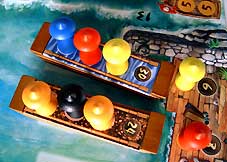 |
| x |
|
|
|
|
|
|
|
|
|
|
|
|
|
|
|
|
|
|
|
|
|
|
|
|
|
|
|
|
|
|
|
|
|
|
|
|
|
|
|
|
|
|
|
|
|
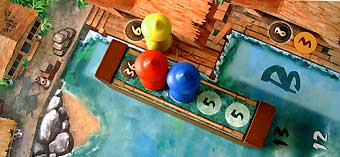 |
|
There is some manipulation along the shore that can be done, to begin with the pier: a player that thinks at least one ship will enter the harbour, takes a low risk that needs low investment but also low pay out. Courageous investors put a trade representative at pier C in hopes of the arrival of all three ships; their investment is only 2 pesos but the possible return 15 pesos.
|
| x |
|
|
|
|
|
|
|
|
|
|
|
|
|
|
|
|
|
|
|
|
|
|
|
|
|
|
|
|
|
|
|
|
|
|
|
|
|
|
|
|
|
|
|
|
|
| A player also can take a bet on slow and rickety ships; it sort of resembles the cynical dragging about with the debts of the Third World! In doing so, a player puts a token at the docks when he thinks a ship will not make it across the finish. Investments and revenues in the docks are the same as in the harbour. |
| x |
|
|
|
|
|
|
|
|
|
|
|
|
|
|
|
|
|
|
|
|
|
|
|
|
|
|
|
|
|
|
|
|
|
|
|
|
|
|
|
|
|
|
|
|
|
| Players who want to give the die a hand, can take positions at the pilots. There are two of these, against differing cost; a large and a small pilot. The large pilot may, preceding the third dice round, place one ship two positions forwards or backwards, or two ships one postion each. Before this, the small pilot has had his chance; he may change a single ship one position forwards or backwards. |
|
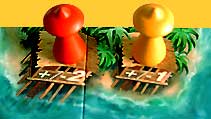 |
| x |
|
|
|
|
|
|
|
|
|
|
|
|
|
|
|
|
|
|
|
|
|
|
|
|
|
|
|
|
|
|
|
|
|
|
|
|
|
|
|
|
|
|
|
|
|
| x |
|
|
|
|
|
|
|
|
|
|
|
|
|
|
|
|
|
|
|
|
|
|
|
|
|
|
|
|
|
|
|
|
|
|
|
|
|
|
|
|
|
|
|
|
|
 |
|
|
|
|
|
|
|
|
|
|
|
|
|
|
|
|
|
|
|
|
|
|
|
|
|
|
|
|
|
|
|
|
|
|
|
|
|
|
|
|
|
 |
|
|
|
|
|
|
|
|
|
|
|
|
|
|
|
|
|
|
|
|
|
|
|
|
|
|
|
|
|
|
|
|
|
|
|
|
|
|
|
|
|
 |
|
|
|
|
|
|
|
|
|
|
|
|
|
|
|
|
|
|
|
|
|
|
|
|
|
|
|
|
|
|
|
|
|
|
|
|
|
|
|
|
|
| x |
|
|
|
|
|
|
|
|
|
|
|
|
|
|
|
|
|
|
|
|
|
|
|
|
|
|
|
|
|
|
|
|
|
|
|
|
|
|
|
|
|
|
|
|
|
 |
|
|
|
|
|
|
|
|
|
|
|
|
|
|
|
|
|
|
|
|
|
|
|
|
|
|
|
|
|
|
|
|
|
 |
|
|
|
|
|
|
|
|
|
|
|
|
|
|
|
|
|
|
|
|
|
|
|
|
|
|
|
|
|
|
|
|
|
|
|